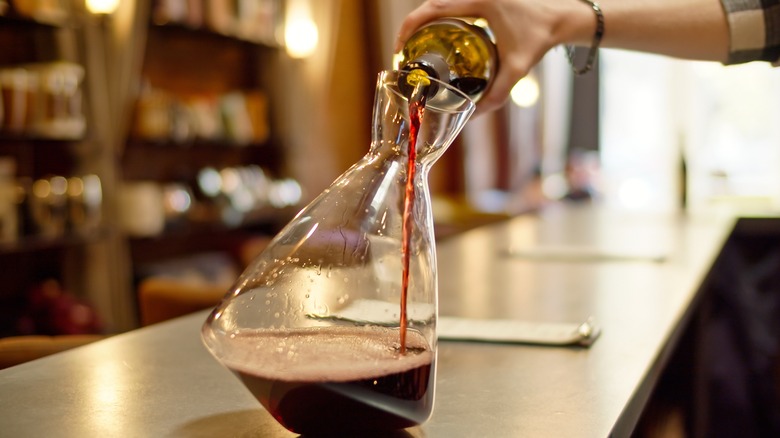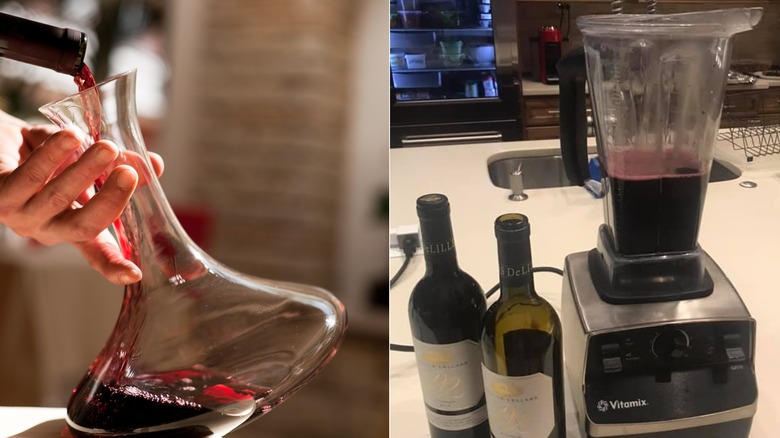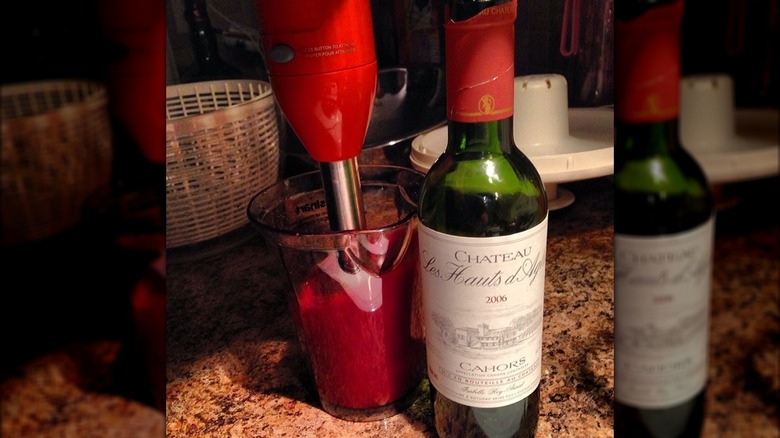You Shouldn't Hyper-Decant Your Wine, Says One Expert
While terroirs and flavor profiles are differentiating factors between old world wines and their new world counterparts, our overall approach to wine — its production, consumption, and even how we let it breathe — has shifted. Bulk wines are getting popular, and boozy, fruity "party wines" like XXL are flying off the shelves. Even old world wines aren't safe from getting the new world treatment, and one such way that is happening is hyper-decanting.
Like many modern-day changes to wine culture, hyper-decanting is a process that claims to do away with elaborate processes in favor of efficiency. The practice first got mainstream attention in 2011 in a how-to piece by Nathan Myhrvold that appeared in Bloomberg. Myhrvold is the former CTO of Microsoft and principal author of the iconic contemporary cooking guide Modernist Cuisine and its successive culinary books, where hyper-decanting also makes an appearance. Since then, the move has been tested out by numerous wine drinkers with mixed results.
If you watched Connor Roy pour wine out of a blender jar on the HBO drama "Succession" and thought, well, billionaires probably know what they're doing when it comes to their liquor, think again. We reached out to Gabriel Corbett, Sommelier of the two Michelin-starred JÔNT of Washington, D.C., to weigh in on the matter and learned that hyper-decanting makes you miss many of the best parts of your wine.
Decanting wine vs. hyper-decanting wine
Decanting is essentially the process of transferring wine from its bottle to another container. Originally meant to get rid of sediments that settle at the bottom of the bottles containing vintage wines, the process also exposes the vino to air. This helps open up the wine's tasting notes and aromas, while also suppressing the harsher tannins. In short, though it's not necessary for all types, decanting makes wine more pleasant to drink, . Of course, unless you store your open bottle of red wine properly, the oxidation continues and saps much of the wine's pleasing attributes. While it may vary depending on the particular vintage, red wine should be allowed to aerate for about 15 to 20 minutes.
This is where hyper-decanting proponents generally say — why wait that long when you can achieve the same result in under a minute? Hyper-decanting involves subjecting wine to a blender. Whether a handheld mixer or a full-size tabletop unit, the red wine is meant to be blitzed till it foams.
As is quite apparent, this swiftly blends air in with the wine, essentially exposing a large amount of the wine's surface area to oxygen. The logic seems sound, and the method also seems to pointedly question the need for the longer, more elaborate ritual of decanting when a faster, more convenient option is available. So, given how long it's been around, why has it not caught on? Corbett has the answer.
Why hyper-decanting can ruin your wine drinking experience
According to the expert Sommelier, the best way to understand a wine is to taste it during various stages of the decanting process. Hyper-decanting, instead, gets you swiftly to the end of the process and you miss many of the intermediate nuances. It's like fast-forwarding through a movie to get to the climax.
Sometimes you may not want to spend the extra time, or the nuances of a particular wine are not of interest and you would like to have it at its best from the first sip. If you're considering hyper-decanting it in this case, there's another caveat. "Even worse is that it (hyper-decanting) could be taken too far and then the wine just falls flat before you've had the opportunity to enjoy it," explains Corbett. Given the process' intensity, extended hyper-decanting can blend away the best parts of your wine.
That said, it's interesting to note that successive popular mentions of hyper-decanting seem to be reducing the duration that vino needs to be blitzed. Myhrvold's Bloomberg article mentions 30 to 60 seconds. A few years later, podcaster and investor Tim Ferriss, proposed doing it for 20 to 30 seconds. And by the time the fictional Connor Roy introduced a bewildered Shiv to the move on "Succession," it was down to 10. Perhaps fans of hyper-decanting also eventually realized they were zooming past the peak of their wine.


